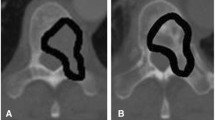Abstract
Purpose To investigate the association between the clinical status of patients with metastatic bone disease and the type of bone metastases. Patients and methods 80 patients with skeletal metastases underwent both clinical and radiological assessments. Bone lesions were evaluated with computed tomography (CT), and patients were separated into three groups: lytic, mixed, sclerotic. Bone density of each lesion was measured in Hounsfield units (HU). Results Patients with osteolytic lesions had the highest mean pain score with 8.1 ± 2.2 points, the least mean scores for quality of life (QoL) and performance status (PS) with 31.4 ± 14.6 and 58.6 ± 9.7 points respectively, the highest percentage and mean opioid consumption (100% and 220.9 mg of oral daily morphine equivalent respectively), and the least mean bone density (116.3 ± 40.4 HU). On the contrary, the group with sclerotic metastases had the least mean pain score with 4.6 ± 1.3 points, the highest mean scores of QoL and PS (61.1 ± 15.5 and 66.6 ± 10 points respectively), the least percentage and mean opioid requirement (55.5% and 170.6 mg respectively), and the highest mean bone density (444 ± 86.6 HU). The differences between the three groups were statistically significant for all parameters evaluated, apart from performance status between the sclerotic and mixed groups. The correlation coefficients were statistically significant between all parameters investigated. Bone density had a strong negative correlation with pain. Conclusion Our results show a clear correlation between the type of bone metastases and the clinical status of patients. Patients with excessive bone resorption suffer the most, and may be given priority in treatment. CT proved to be a practical and efficient method to investigate and classify metastatic bone lesions.





Similar content being viewed by others
References
Brown HK, Healy JH (2001) Metastatic cancer in bone. In: De Vita VT, Hellman S, Rosenberg SA (eds) Cancer–principles and practice of oncology, 6 edn. Lippincott Williams and Wilkins, Philadelphia, pp 2713–2729
Body JJ (1992) Metastatic bone disease: clinical and therapeutic aspects. Bone 13:557–562
Mauskop A, Foley KM (1998) Control of pain. In: Harrigton KD (ed) Orthopedic management of metastatic bone disease. CV Mosby, St Lewis, pp 121–137
Pecherstorfer M, Vesely M (2000) Diagnosis and monitoring of bone metastases: clinical means. In: Body JJ (ed) Tumor bone disease and osteoporosis in cancer patients. Marcel Dekker, Inc., New York, pp 97–129
Vinholes JJ, Purohit OP, Abbey ME et al (1997) Relationships between biochemical and symptomatic response in a double–blind randomized trial of pamidronate for metastatic bone disease. Ann Oncol 8:1243–1250
Peh WCG, Muttarak M (2003) Clinics in diagnostic Imaging (82). Singapore Med J 44(2):101–105
Coleman RE (2001) Metastatic bone disease: clinical features, pathophysiology and treatment strategies. Cancer Treat Rev 27:165–176
Maisano R, Pergolizzi S, Cascinu S (2001) Novel therapeutic approaches to cancer patients with bone metastasis. Crit rev Oncol/Hematol 40:239–250
Iddon J, Byrne G, Bundred NJ (1999) Bone metastasis in breast cancer: the role of parathyroid hormone related protein. Surg oncol 8:13–25
Bonadonna G, Rossi A, Valagussa P et al (1997) The CMF program for operable breast cancer with positive axillary nodes. Cancer 39:2904–2915
Chow E, Holden L, Rubenstein J et al (2004) Computed Tomography (CT) evaluation of breast cancer patients with osteolytic bone metastases undergoing palliative radiotherapy–a feasibility study. Radiother Oncol 70:291–294
Karnofsky DA, Abelmann WH, Craver LF et al (1948) The use of the nitrogen mustards in the palliative treatment of carcinoma. Cancer 1:634
Aaronson NK, Ahmedzai S, Bergman B et al (1993) For the European organization for research and treatment of cancer QLQ-C30: a quality of life instrument for use in international trials in oncology. J Natl Cancer Inst 85:365–376
Storto G, Klain M, Paone G et al (2006) Combined therapy of Sr-89 and zoledronic acid in patients with painful bone metastases. Bone 39:35–41
Vassiliou V, Kalogeropoulou C, Christopoulos C et al. (2007) Combination ibandronate and radiotherapy for the treatment of bone metastases: clinical evaluation and radiologic assessment. Int J Radiat Oncol Biol Phys 67(1): 264–272
Chow E, Ling A, Davis L et al (2005) Pain flare following external beam radiotherapy and meaningful change in pain scores in the treatment of bone metastases. Radiotherapy Oncol 75:64–69
Umatsu T, Yuen S, Yukisawa S et al (2005) Comparison of FDGPET and SPECT for detection of bone metastases in breast cancer. AJR 184:1266–1273
Southard TE, Southard KA (1996) Detection of simulated osteoporosis in maxillae using radiographic texture analysis. IEEE Trans Biom Eng 43:123–132
Author information
Authors and Affiliations
Corresponding author
Rights and permissions
About this article
Cite this article
Vassiliou, V., Kalogeropoulou, C., Petsas, T. et al. Clinical and radiological evaluation of patients with lytic, mixed and sclerotic bone metastases from solid tumors: is there a correlation between clinical status of patients and type of bone metastases?. Clin Exp Metastasis 24, 49–56 (2007). https://doi.org/10.1007/s10585-007-9056-z
Received:
Accepted:
Published:
Issue Date:
DOI: https://doi.org/10.1007/s10585-007-9056-z




